Restaurant Menu Design: The Top 8 Mistakes To Avoid
A fancy food ad can get people to notice your restaurant. The moment your guests step into your restaurant, a combination of things like the ambiance, the food served, and hospitality influences the customer experience.
And a good customer experience has them coming back to your restaurant.

But in the midst of all this, there is one other underrated marketing material that actually has a big influence on the overall experience – the restaurant menu design.
Your restaurant menu is likely the first tangible asset of your brand that your guests hold in their hands. So, this one deserves a fair share of your attention.
Do you think a list of items served at your restaurant and some pictures of food will be enough to design a restaurant menu? Not at all. If only it were that simple!
Good restaurant menu design, in fact, is more about the experience than just about the design. It should make your guests visualize your food and experience your brand even before they order anything. So, you cannot let seemingly simple design mistakes hamper the whole experience for them.
What are these mistakes that can reduce the effectiveness of a restaurant menu design? We’ll look at them in detail in this blog.
Restaurant Menu Design Mistakes and Kimp Tips to Eliminate Them
31% of restaurants update their menus every month. But if you have a timeless menu design, you do not have to change it too often.
And when you do change your menu design, you should be sure that you are not making common design mistakes. Let’s look at these design mistakes and some tips to avoid them.
1. Ignoring the eye-tracking patterns
Sometimes a menu design looks perfect. There is a clear hierarchy and the layout is straightforward but it still does not have the intended effect. Do you know why? This can be because the design ignores the eye-tracking patterns.
Whether we are reading a web page or a menu, we don’t usually read word by word, line by line. Go ahead. Pick a random flyer or newspaper page and give it a shot. Notice how your eyes jump from one point to another skipping everything that lies in between. This is called an eye-tracking pattern. And most people follow common patterns called F-patterns, Z-patterns, and so on when reading.
Kimp Tip: Restaurant menus have a lot of content. Most guests do not read the whole thing. So, try incorporating the well-known eye-gaze patterns in your menu design. It makes quite the difference! Place profitable items on your menu at the points where most people focus. Working with an experience designer can help you navigate this aspect of design with ease!

In the above menu design, for example, the box on the top right corner quickly grabs attention. And the rest of the items are also arranged in clear and easy-to-identify groups. Menu designs like these are perfect to promote the items you wish to sell more.
2. Not having a solid plan in place
The restaurant menu design below is a good example of the idea that “failing to plan is planning to fail”.
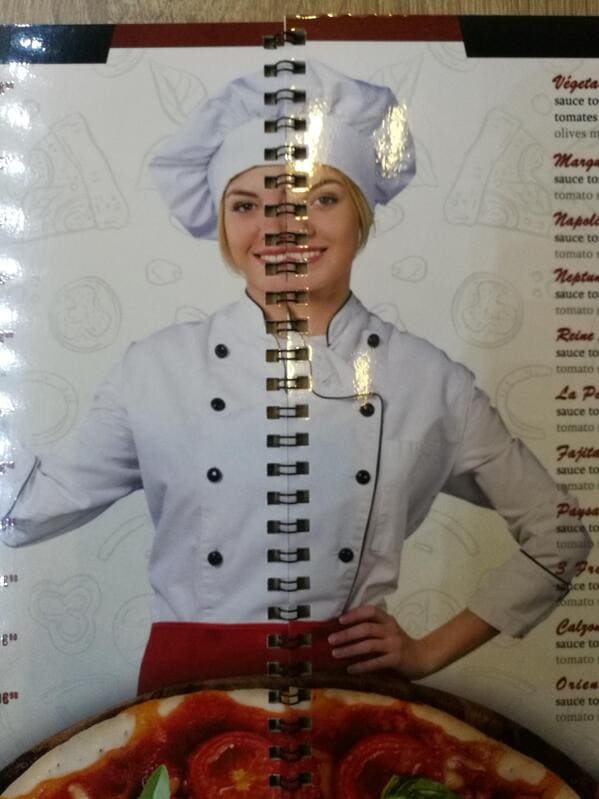
Even the best of designs will be futile when the final menu layout does not comply with the design. The proper way to account for this is to finalize the menu layout, and the number of folds or pages, even before you finalize the menu design. You do not want graphics to be cropped or text sections to lie awkwardly close to each other. These little hiccups can create a lot of clutter.
Kimp Tip: The key is to visualize your design from page to page. In the example below, you can clearly see what part of the design appears on each page. This makes it easier to get a rough picture of your menu before printing it. This way, you can be sure that the graphics or the text do not appear cropped or warped when your design is printed out.

Wondering how to get a fuss-free visualization of your restaurant menu before printing it? With the Kimp Graphics subscription, you can get a clear image of what your design looks like in print. With unlimited revisions, you can tweak your design until it feels perfectly in line with what you had in mind.
3. Not connecting it with the rest of your marketing channels
Some restaurant menus only focus on the food being served. The key to good restaurant marketing is to build a rapport with your customers, not just the promotion of the brand.
Connecting and engaging with your customers on social media is a vital part of customer relationship building. If your menu only contains information about food and if there is nothing about your social media handles or contact information on it, you are missing out on a good opportunity.
Food orders through digital channels are projected to reach 30% of the total restaurant sales by the year 2025. And this has pushed restaurants to actively use online channels for food ordering. When you do offer these benefits but your menu does not talk about them, it will still be of no use.
Kimp Tip: The type of contact details you provide depends on the type of menu. It also depends on where the menu will be used. Is it a table menu or a takeaway menu that customers carry back with them? In the former, adding your social media handles will be sufficient. But with the latter, you should clearly provide contact details including phone number and address. And it should contain the details of your social media pages.
Use boxes and variations in font colors to draw attention to the contact details section. Your customers should easily see that they can connect with your restaurant on social media.
If you have gift voucher options, table booking facilities, or loyalty programs, add a brief few lines about these as well.

The above restaurant menu crisply displays the contact information at the bottom corner. Because that is probably the last place that most people will look. And this will make them remember the contact details more easily.
4. Giving all the items the same priority
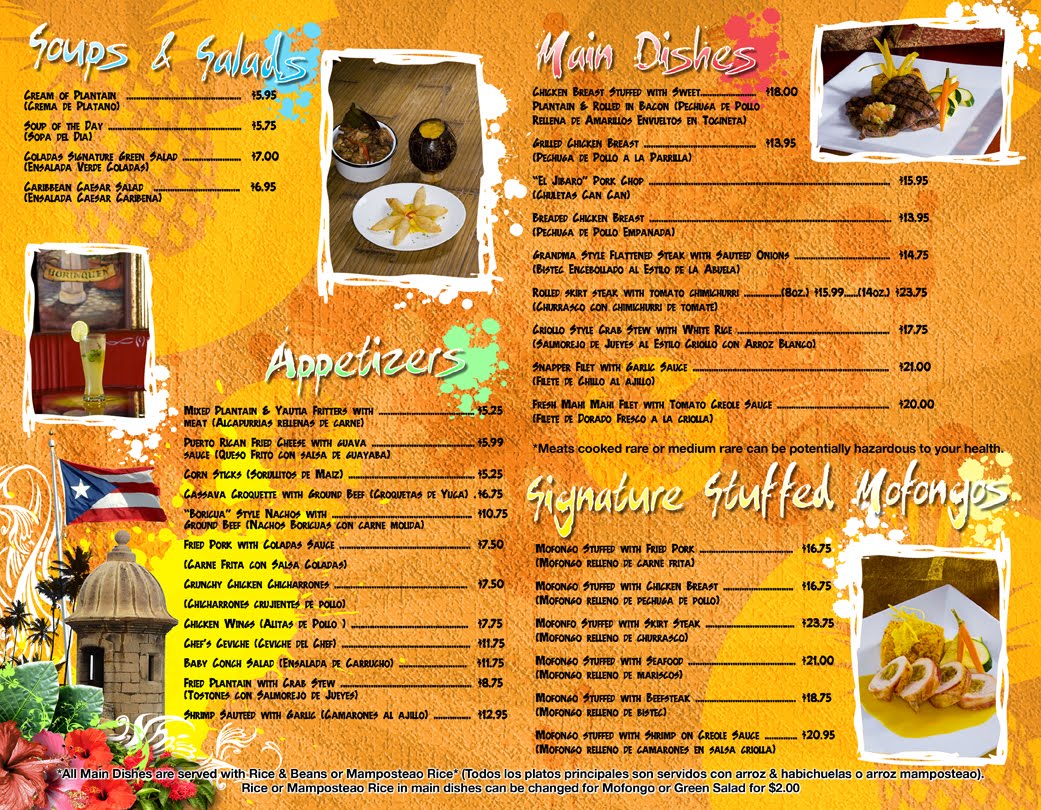
When you look at the above menu, at the first glance everything looks fine. But what about looking at this menu when you are hungry? What if you are visiting the restaurant for the first time and you know nothing about what’s served at the restaurant. Will this menu tell you what to try? Or what’s special at the restaurant? Probably not. That’s because all the items and all the sections have the same weightage in the above design.
Priorities for items on your menu might depend on what is popular in your restaurant or items with the best profit margins. Whatever be your strategy, you should prioritize items on the menu and have a clear layout that emphasizes these priorities.
Kimp Tip: Use design elements that help draw attention to specific sections on the menu. Some use color or font variations to achieve this. One other way to do this is to add boxes to separate such special items on the menu. See how the example below incorporates this idea.

The restaurant menu design above draws attention to the sides. In most restaurants, these are often the most profitable items. And they are also the items that guests mostly ignore. So, attracting attention to them is a great move.
5. Ignoring color contrasts
Can you read every item on the menu below without straining your eyes? You can’t. Blame it on the contrast.
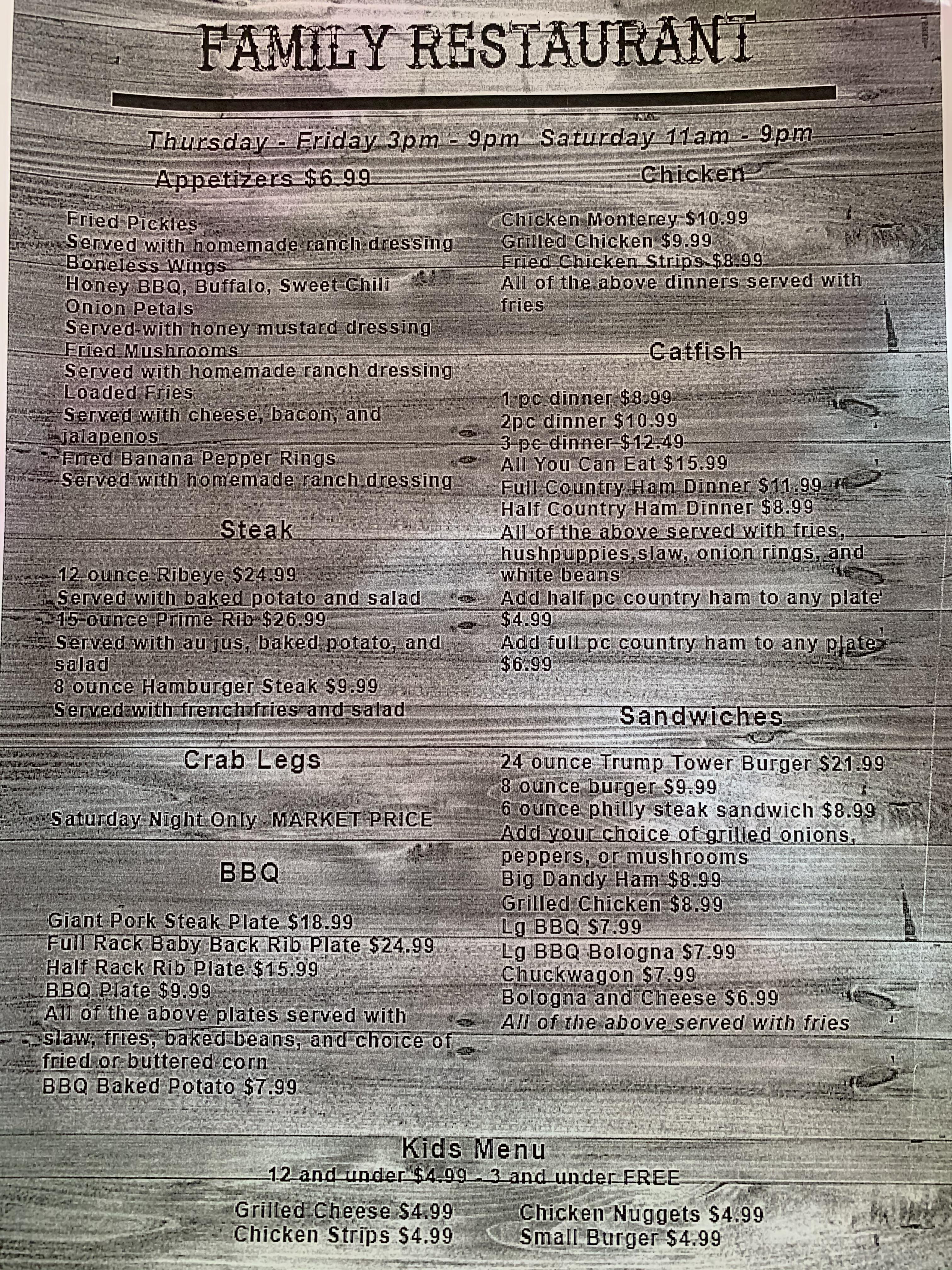
Sometimes this happens if the designs intended to be printed in color are printed out in monochrome. But sometimes it is also because the design pays no attention to the color contrasts. Poor contrasts lead to a lack of legibility in the text. And this can be due to two reasons:
- Font colors do not stand out from the background colors
- A visually busy background or a patterned background causes the letters in the foreground to be difficult to read
Hungry customers do not want to spend too much time trying to figure out what is written on the menu. So, poor contrasts affecting the readability of the menu can dampen the whole experience.
Kimp Tip: Try to keep the background simple and clean. If you do want to add illustrations or visuals, separate them from the text section. Enough negative space around the text will make the text easier to read. The restaurant menu design below does that perfectly.

The food illustrations in the above design are neatly tucked away from the text. And the choice of font colors makes the text pop out. This ensures that the guests read the items without any difficulty.
6. Creating visual chaos
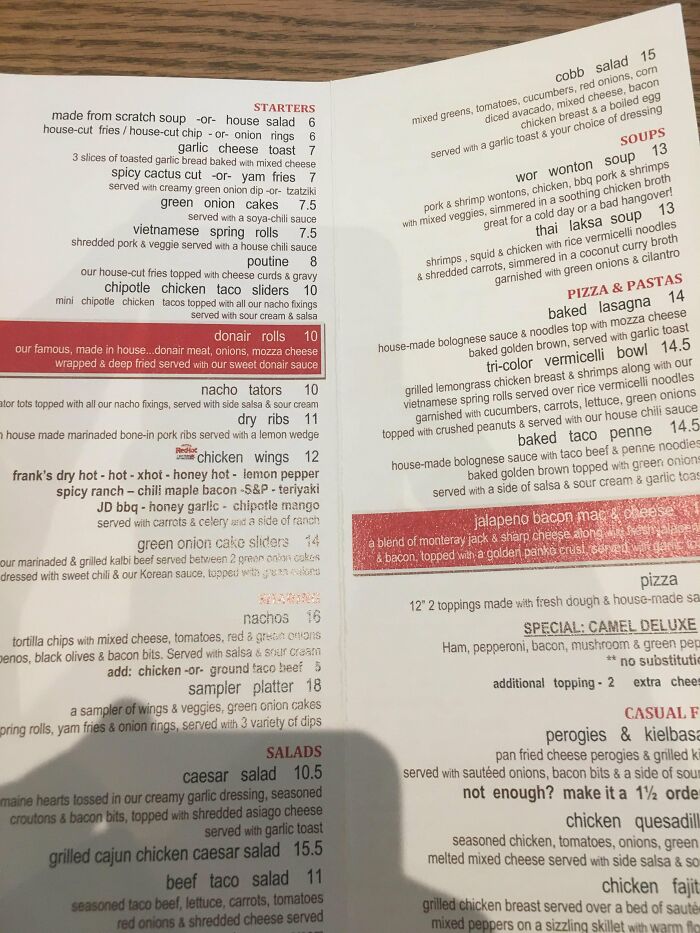
In the above menu design, there is a lot of information which can be a good thing. Description makes people visualize the food and thus feel more confident about ordering it. But description becomes a problem when too much text leads to visual clutter. In the above image, the text is all over the place. With a design like this, guests will not know where an item ends and where the next one on the menu begins.
The visual clutter in the above example is due to three main reasons:
- Insufficient spacing between the items
- Inconsistent font styles
- Alignment of the text
All these can make the menu uncomfortable to read. Your menu should alleviate the stress of choosing items. Not add to it. So, try to keep things more organized on the menu.
Kimp Tip: Use a cleaner and simpler layout like the one in the below menu design. This will make it easier for your customers to navigate through the content.

Define sections like appetizers, sides, and others. For the section headings, body text, and other repeated blocks, maintain consistency in font styles. This will make the design easier to understand.
7. Poor choice of fonts
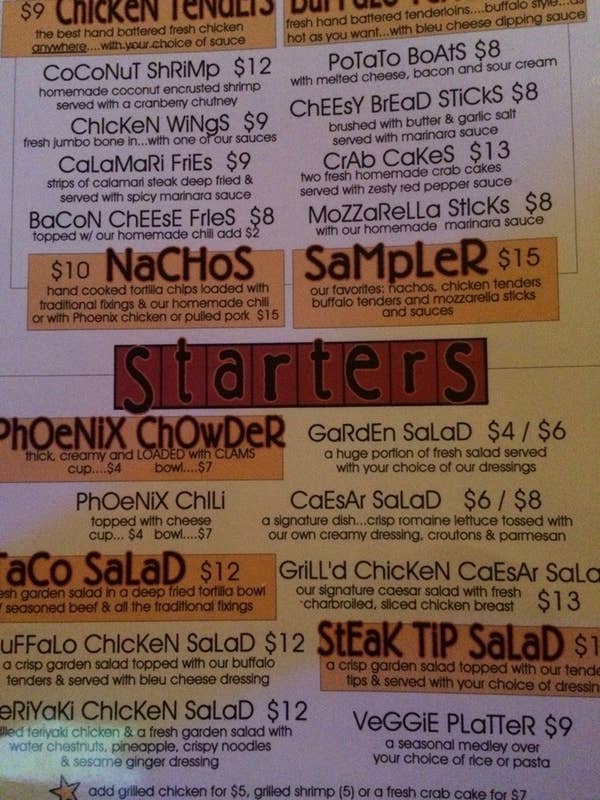
Complicated font choices as you see in the above design can cause too much noise. The font style ends up distracting your guests from what matters.
The common mistakes when it comes to choosing fonts for a menu design are:
- Choosing fonts that are difficult to read
- Using too many typefaces or font styles
- Showing no variation in font styles and typefaces
You need font variations to indicate hierarchy. But too many font styles lead to visual inconsistency. Fonts that look fancy on ads aren’t necessarily easy to read when you have lines and lines of text, as in the case of a restaurant menu.
Kimp Tip: Pick fuss-free font styles that are easy to read. For restaurants that want to capture a vintage vibe or traditional designs, there are serif fonts that are highly legible. And for restaurants that want something more modern, sans-serif typefaces come in all shapes and sizes.
Decorative typefaces, as well as script fonts, can be used in the hero text or offer sections within the menu. Take a look at the below menu design, for example.

While the menu uses a sans-serif typeface for readability, the specialty section incorporates more fun styles to go with the theme.
Does choosing the right font for your menu design appear intimidating? Leave it to the Kimp Team.
8. Not setting the right vibe
Meticulously planning your restaurant menu design will not be enough. Whether it is an online menu or a physical one offered at the restaurant, your menu design should resonate with the ambiance of your restaurant. A plain and uninspiring menu for a fancy fine dining restaurant as well as a posh-looking menu for a simple fast food joint will both look out of place.
If your diners find no connection between your restaurant menu design, signage, decor, and other elements of the ambiance, it will not create a strong impression on them.
Kimp Tip: Your restaurant menu should be a part of the guest experience. It should reflect what your restaurant offers in terms of ambiance and service. Smart choice of fonts, color schemes, and other design elements help set the right mood. Take a look at the below menu design for example.

Even before you read the text you must have guessed the Viking theme of the design. That’s the kind of effect you will want in a restaurant menu. And it works particularly well for themed restaurants with a distinct ambiance.
And with that we wrap up the most common mistakes that most restaurant owners make while designing their menus. For effective strategies to help you start off on the right track, check out our other blog post on restaurant menu design tips.
Design Catchy Customer-Centric Restaurant Menus With Kimp
Want a delicious food ad that brings people to your restaurant? How about menu designs that lay the foundation for a solid customer experience? Get it all designed by one team! That’s the benefit of choosing graphic design subscriptions. You don’t have to find designers for each and every one of your design projects. One subscription takes care of all your restaurant marketing designs.
Want to get a taste of what an unlimited graphic design subscription can do for you? Sign up for Kimp’s free trial today.
